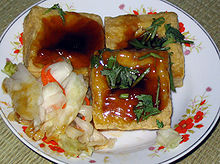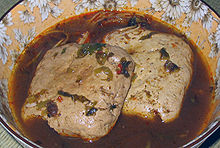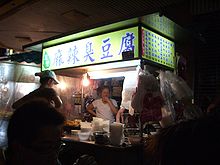- Stinky tofu
-
Stinky tofu 
Deep fried version of stinky tofu Chinese 臭豆腐 Literal meaning stinky tofu Transcriptions Gan - Romanization chhiu2 theu5 fuh Hakka - Romanization Tshu-theu-fú Mandarin - Hanyu Pinyin chòu dòufu Min - Hokkien POJ chhàu-tāu-hū Cantonese (Yue) - Jyutping cau3 dau6 fu6 Stinky tofu or chòu dòufu is a form of fermented tofu that has a strong odor. It is a popular snack in East and Southeast Asia, particularly mainland China, Taiwan and Hong Kong and in East Asian enclaves elsewhere where it is usually found homemade, at night markets or roadside stands, or as a side dish in lunch bars rather than in restaurants. It is listed at number 41 on World's 50 most delicious foods complied by CNN Go in 2011.[1]
Contents
Production
Unlike cheese, stinky tofu fermentation does not have fixed formula for starter bacteria; wide regional and individual variations exist in manufacture and preparation.
The traditional method for producing stinky tofu is to prepare a brine made from fermented milk, vegetables, and meat; the brine can also include dried shrimp, amaranth greens, mustard greens, bamboo shoots, and Chinese herbs.[2] The brine fermentation can take as long as several months. Although stinky tofu is very popular in East and Southeast Asia, not many households prepare stinky tofu brine at home due to its strong odor, especially in metro-residential areas.
Even though the traditional method is still widely practiced by street vendors, modern factories often use quicker methods to mass produce stinky tofu. Fresh tofu is marinated in prepared brine for only a day or two, especially for fried or boiled cooking purpose.[3] The process only adds odor to the marinated tofu instead of letting it ferment completely.
The nature of the stinky tofu production process makes it extremely difficult to pass government food regulation even in Asia. The diversity and lack of formulated methods also makes it nearly impossible for any government to regulate and inspect.[4] In Asia, no stinky tofu factories were ever officially licensed or constantly monitored; in most cases, government inspection can only focus on the cooking procedure and ventilation.[5]
In North America, stinky tofu is often "home-made" in cities with significant numbers of Asian immigrants. For example, some Asian tofu factories in Vancouver, Canada produce stinky tofu underground as a side-business to avoid government inspections.[6]
Preparation
Stinky tofu can be eaten cold, steamed, stewed, or most commonly, fried. It is often accompanied by chili sauce. The color varies from the golden fried Zhejiang-style to the black typical of Hunan-style stinky tofu.[2]
From a distance, the odor of stinky tofu is said to resemble that of rotten garbage or manure, even by its enthusiasts. In some instances the taste has even been compared to rotten meat. In spite of stinky tofu's smell, most say the flavor is surprisingly mild. It is said the more it smells, the 'better' its flavor.[2] Some few people have compared it to the taste of blue cheese.[7] It has also been compared to foie gras.
Regional
Mainland China
Stinky tofu is made and consumed in different ways in various areas of China. For example, the types of dried stinky tofu made in Changsha and Shaoxing are both very popular, but they are made with different methods, and the resulting flavors are very different. The most famous shop for stinky tofu in Changsha, Huo Gong Dian, makes the tofu with yellow soybeans marinated in seasoning. The stinky tofu sold in Tianjin is mostly made in the Nanjing style, with a mild aroma. In Shanghai, stinky tofu is fried and sold on streets, typically served with a spicy or sweet sauce. It is also served as a condiment to Congee, a kind of rice soup that is quite neutral in its own flavour, often as a part of a regular breakfast meal. In Chongqing, stinky tofu on the streets is usually fried and dipped in a mixture of, typically, coriander (cilantro) leaves, scallions, chili powder, Sichuan pepper and oil. Stinky tofu is also sometimes dipped in Sichuan spicy hot pots. Also, close to a hundred manufacturers of stinky tofu in Guangdong province were found to use a combination of sewage, slop, and Iron(II) sulfate to accelerate production and improve appearance of their fermented product.
Taiwan
Stinky tofu is one of the most recognizable dishes in Taiwan. It is very commonly served on roadside stands and in night markets. It is usually served deep fried (often served drizzled with sauce and topped with sour pickled vegetables), grilled, or added to a Sichuan mala soup base (with solid goose blood.)
Hong Kong
In Hong Kong, stinky tofu is a trademark street food, along with fishballs and beef balls. The street style is rather plain. It is deep fried fresh at hawkers' stalls and at dai pai dongs. It is sold by the bag, and is well-known for the tremendous amount of grease it contains. Hong Kong-style stinky tofu is traditionally eaten with hoisin sauce.[8]
References
- ^ CNN Go World's 50 most delicious foods 21 July 2011. Retrieved 2011-10-11
- ^ a b c Xiaomi, Tan (2006-06-02). "Stand back! Stinky tofu chain stores arrive in Shenzhen". Shenzhen Daily. http://paper.sznews.com/szdaily/20060602/ca2324508.htm.
- ^ "臭豆腐秘密基地 直擊製作過程!". 華視新聞網. http://news.cts.com.tw/cts/general/200910/200910080327597.html.
- ^ "臭豆腐長蛆是否有礙健康 政府有責任澄清". The Epoch Times. 10/2/2003. http://www.epochtimes.com/b5/3/10/2/n386865.htm.
- ^ http://www.districtcouncils.gov.hk/sk_d/chinese/doc/Minutes/FEHC_0506_5_mc.doc[dead link]
- ^ "廚藝討論::臭豆腐的醃製方法". 2000/8/4. http://www.ytower.com.tw/mailbox/detail.asp?TitleID=287.
- ^ Lennox, Craig (January 28, 2010). "Chou doufu: the origins of stinky tofu". Global Times. http://www.globaltimes.cn/www/english/metro-beijing/lifestyle/health&food/2010-01/501927.html. Retrieved 14 July 2010.
- ^ CNN Go 40 Hong Kong foods we can't live without 13 July 2011. Retrieved 2011-10-09
See also
Taiwanese cuisine Dishes and meals - Bento
- Congee
- Geng
- Karasumi
- Misua
- Mongolian barbecue
- Oyster vermicelli
- Pork ball
- Rice vermicelli
- Sanbeiji
- Shabu-shabu
- Tilapia (braised)
- Ying Yang fish

Xiaochi Snacks and desserts Beverages Ingredients Miscellaneous Soy General Soy allergy · Soy candle · Soy ink · Soy molasses · Soy paint · Soy protein · Soybean · Soybean diseases · Soybean meal · Soybean oil

Soy based dishes Aburaage · Agedashi tofu · Bai ye · Douhua · Dubu kimchi · Edamame · Hiyayakko · Kongguksu · Kongnamul · Mapo doufu · Miso soup · Sundubu jjigae · Tahu goreng · Tofu skin roll · Yong Tau Foo
Milk substitute Meat analogues Sauces and condiments Dajiang · Doenjang · Doubanjiang · Douchi · Kinema · Miso · Nattō · Soy sauce · Teriyaki · Tauco · Tian mian jiang · Tương · Yellow soybean paste
Various other foods Companies 8th Continent · Alpro · Boca Burger · Gardenburger · Morningstar Farms · Silk · So Good · Tofutti · Turtle Mountain · Vitasoy · Yeo Hiap Seng
Hunan topics General Geography Cities • Yangtze River • Xiang River • Zijiang River • Yuanjiang River • Lishui River • Wuling Mountains • Xuefeng Mountains • Nanling Mountains • Luoxiao Mountains • Lake DongtingEducation Hunan University • Hunan University of Arts and Science • Hunan Normal University • Hunan Agricultural UniversityCulture Cuisine Stinky tofu • Dong'an chickenVisitor attractions Categories:
Wikimedia Foundation. 2010.


